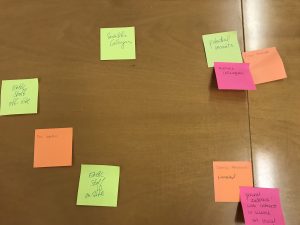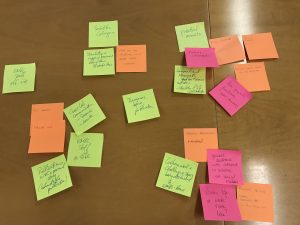Building your blog
A little while ago now I ran a blogging workshop in Rome for writers on their “On brains & beer” blog. But while we tailored the work there to the people in Rome, a lot of the things we discussed are more universal. So in the spirit of openness, this is some of what we covered. If you are at EMBL and would like a similar workshop, please let me know.
I start most of my presentations with this brilliant cartoon by Tom Gauld. It’s also stuck up in my office. It’s my reminder that the researchers at EMBL (and beyond) are perhaps a bit busy. Their first, second, third or even fourth thought is probably not about what might work well on a specific social media platform. But that’s what I’m paid for. So that’s my first lesson for researchers thinking about reaching new audiences through a blog:
Don’t panic: Your primary job is not comms but as with all things, you only get better if you practice
Just write
Every successful blog is built on a solid foundation of content, but it’s consistency that’s the real key. But how, when your job isn’t blogging?
- Keep note of ideas. Build a backlog even if it’s just a title or a rough idea. (I’ve had this post in my backlog for about a month)
- Pick a time (once a month?) to go through and pick a topic
- Outline what you want to say for that post. At a minimum some subheads. Not extra reading or images you need.
- First draft – take <1 hour in two 20 minute bursts. Just write. Don’t edit.
- Refine – focus on the title, how you open and close the post
- Edit – re-read. Does it say what you want to say? Remember the blog post’s aims
Plus a few extra tips
- Optimise with key words. But don’t stress too much about them. Search engines are pretty smart now. Just make sure the words you want your blog to be about are in the text, title and url. Which leads to…
- Make the url and title meaningful. Puns are fun, informative titles are more findable.
- Use subheads and images to break up the text
- Use active first hand language – you pipetted the solution, not the solution was pipetted
Post types
So what types of posts work well on blogs?
- The How-To Post – help people and they will thank you
- The Curated Collection/ aggregationPost – think of it bit like a lit review. Collect content but ADD value
- The List-Based Post – top 5 cell types. Top 10 things you learnt at EMBL etc etc
- The SlideShare Presentation Post – done a talk? Presented a poster? Blog it!
- Behind the scenes post – a personal take on an event, a paper publication etc
- The Newsjacking Post – something in the news related to your research? Blog about it.
But what if you want to get a bit more focussed. What if writing into a void is not your aim. What you need is a strategy.
Starting a Strategy
Building a comms strategy at its basic level is working out what to say, when to say it, and how best to do that. Simple…
Step one is to think about who you want to talk to. Your audience. And both what you want to tell them and what they want to hear from you. In the Rome workshop we used our trusty sticky notes to list the people we wanted to talk to and then tried to assemble them into groups. Were there cross overs etc?

Step two is to think about the messages. What you want these people to know. Do they have key questions? Tasks?

By doing this you should be able to answer the questions: Who are you talking to? What are you saying? Why are you saying it?
If you’ve been writing for a while, you might also have some numbers to show what your most popular blog posts were. Slowly you can build up an idea of the sort of stuff that works. If you publish more often you might even get an idea of the best day/time to post.
Just keep writing
If we put it all together what we get is a set of steps.
- Pick an audience
- Pick a message/audience need/task
- Pick a post type
- Write a post
- Edit the post, make sure there are suitable images/subheads etc.
- Publish
- Share even if it’s just emailing your mum a link
- Repeat
What really matters is making stuff that’s useful/interesting. And keeping the material coming.
If you’re interested in more detail about building strategies, content calendars and/or analytics let me know. These are all article ideas I have in my backlog.